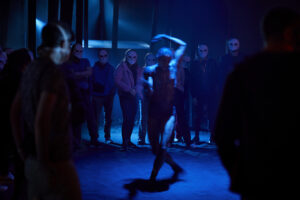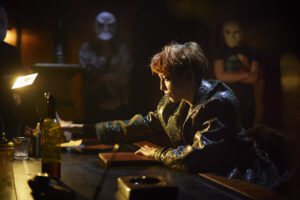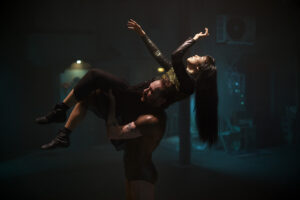Impressive but confusing immersion into the Trojan War
★★★

The Burnt City is hard to understand and difficult to find your way around. So, this is not only a review of the show but a guide to how to get the best out of it.
Punchdrunk are the leaders in ‘immersive theatre’, in which you are right in the middle of what’s going on. There are lots of stories being told in The Burnt City. They add up to a beginning, middle and end, but not necessarily in that order. Like anything you’re in the middle of, you don’t have the big picture until afterwards, if then.
I usually love this form of theatre so I was desperate to see The Burnt City, but once there, my desire turned to disappointment. I had expected this show about the myths of the Trojan War to be non-linear. As you walk around the 100 thousand square feet of floorspace, you don’t expect to understand what’s going on. As you might be told if you ask for directions, ‘Let fate be your guide’.
There are many stories being told simultaneouslly throughout two buildings,. They are repeated but don’t expect them to be chronological. I had a general idea of the many Ancient Greek myths connected with the Trojan War but I still struggled to identify or connect them. It doesn’t help that they’re mostly told through through dance, rather than spelled out using the spoken word.
I witnessed many events. What I didn’t expect was how uneventful the events would be, how lacking in dramatic tension. The biggest tension is the fear that while you’re watching one event, you’re missing something much more dramatic in another room.
I may not have been as engaged as I would liked to be, or found the events as dramatic as I think they should have been, but it’s still a great experience to be immersed in this world of war and revenge, and to be standing right next to its inhabitants as they meet their fate.
So what is The Burnt City about? It’s based primarily on two Ancient Greek plays, Euripides’ Hecuba and Aeschylus’s Agamemnon, that cover the war between Mycenae (or Greece) and Troy, the largely mythical Trojan War. Will it help if you know these plays? Probably not that much.
What does help is that, as you enter the building, there’s a brief audio history of the Trojan War and its aftermath, so you’ve a fair idea of the big moments you may see. You go through a faux museum which is even more helpful in explaining the events. So, my advice is to take a few moments to look at the exhibits. The case containing the last exhibit has been broken open, as if to say the past is now coming to life. You’re then in for three hours with no interval, unless you choose to take a break.

Punchdrunk have acquired their own home for the first time in their twenty plus year history, and have converted their building at One Cartridge Place in Woolwich and the adjoining one into Mycenae and Troy. The sets by Felix Barrett, Livi Vaughan and Beatrice Minns are extraordinary. There is astonishing attention to detail. Mycenae is inspired by perhaps Fritz Lang’s 1920s film Metropolis. Troy suggests a period before the Second World War with a neon sleaze reminiscent of 1920s Berlin.
After the museum, you make a choice about where to go first. Lights beckon you but, to help you find your choice, look carefully and you see signs, one welcoming you to Troy which is down a long tunnel, the other a border crossing gatehouse to Mycenae. Each space has two floors. In both, you witness violent acts or feel the threat of violence but in Troy you find people having fun, while the city is under attack, and you can wander through small spaces and a warren of rooms. On the other side, there’s gloomy Mycenae, a military state where the warriors prepare for war, then return and face its consequences. Here there are two large open areas, downstairs is what appears to be a military camp, upstairs a palace. There are only a few rooms off.
This show, directed by Felix Barrett and Maxine Doyle, is much more about the effect of war than the fight itself, and cycles of revenge dominate. So what are the big moments?
First, at the start of the war, Agamemnon sacrifices his daughter Iphigenia to the Gods in exchange for good fortune. You need to look for a bride getting ready for what she thinks is a wedding. This is in one of the few rooms in Mycenae. You can then watch her taken to the ground floor and placed on one of two giant tank traps, which look like misshapen crucifixes, on which she is killed. Agamemnon’s wife Clytemnestra is not happy about this, but more of that later.
Over in Troy, the Greeks invade using the famous Trojan Horse (which apparently is there is some form but not obvious, so it’s something to look out for). Queen Hecuba’s daughter Polyxena is murdered by invaders and strung up. I found this to be one of the most upsetting scenes.
Hecuba has learned that King Polymester, an ally of the Greeks, has murdered her son, whom she sent to him for safekeeping. He doesn’t know she knows. When he arrives in Troy, she and fellow women do a friendly dance with him in a red room, possibly a nightclub, on the top floor, that eventually turns violent as they overwhelm and blind him.
Back in Mycenae, Agamemnon arrives home in triumph with Cassandra in tow. You can recognise him by his splendid gold head mask, just one of dozens of imaginative, almost superhero costumes by David Israel Reynoso, inspired by Ancient Greece. Agamemnon’s wife Clytemnestra greets him. He goes upstairs where there is a huge block, made of concrete (I think), like a fashion show runway, where he is at first feted, until he takes a shower and Clytemnestra, in revenge for his killing of their daughter, goes all Psycho. It’s one of the more horrific moments, but even so, I found that, because of the time it took to get to that point, with all the slow entwined dancing, it became boring rather than tense.
All the events are repeated so you have three opportunities to see them. If you know what you’re looking for, you can hope to see them all in three hours
Stay until the end because, given that killing is a dominant theme, there is a climax in which many of the performers take part in a kind of techno dance of death, half naked and possibly in hell, but more literally in Mycenae.
A useful approach may be to follow what you might call the wisdom of the crowd. If a group of spectators has accumulated, there’s usually something going on. Their spookily anonymous masks, which we are all required to wear, take away individuality, even more so when they form a crowd and are so focused on following a particular train of events, that they almost crush you or push you to one side.
Some people like to fix on one performer and follow them, because these various stories do have beginnings, middles and ends, unlike the overall show, and those beginnings usually start small, build to a climax which may well be a killing, with some kind of anguished coda. I found these events strangely uninvolving but I think I might have felt more involved if I had adopted this approach.
Much to my surprise, and perhaps because there is so much room, I found there were times and spaces when nothing was going on. I went round a whole floor of Troy at one point and saw nothing going on.
While you may feel you want to spend all your time watching things happening, there is much to be gained from exploring some of the nearly 100 (apparently) small rooms in Troy. These are often bedrooms, sometimes shops, seemingly abandoned in the course of the siege or attack. Go into them, or some of them, take a look at the books and pictures, look behind the clothes in the wardrobes. Not only will you get amazingly detailed insights into their lives, but you will also be rewarded with clues as to what’s going on around you.

Perhaps, before you even buy a ticket, I should give you this tip, and it won’t be a surprise if you know Punchdrunk’s past work. This is a dance show, and I don’t mean Anything Goes dance, I mean contemporary dance. There is next to no speech to help you understand what’s going on, and the dancing is nearly always in slow motion, and stretched out. I’m not questioning for a moment the brilliance of choreographer Maxine Doyle or her dancers but, if you’re not familiar with the language of dance (which I’m not) you may struggle to comprehend what it is the dancers are trying to convey. The performers embrace erotically or sinisterly, push each other apart, swing one another around. You’ll find it portentous or pretentious, depending on your opinion of contemporary dance. Personally I like that kind of dance but in small doses, which this isn’t.
This show is not for the claustrophobic, or people with visual impairment. You may find being in the building overwhelming at times because it’s mostly dark, with haze as well on occasion. And there are some trip hazards, even if they are highlighted with tape.
Given such an underlit environment, it seem odd for me to compliment the lighting designers but F9, Ben Donoghue and Felix Barrett have done a great job of adding to the sense of fear and wonder, with their mixture of murkiness, sudden flashes, and bright spotlights.
The sound by Stephen Dobbie with its screeching thudding reverberating chords adds to the febrile atmosphere.
Practical Tips
Let’s start at the beginning. The organisers quite rightly would like you to use public transport to get to the show. But it is in Woolwich, which is a long way from the centre of London, so you, like me, may have to go by car if you’re not going to spend most of your day travelling. The best place to park, I found, is Calderwood Street multi storey Car Park, which is a ten minute walk away from the venue.
Arrive in good time at the venue, at least 15 minutes before your allocated slot, because there will be a queue to get in, even with staggered entry times. You are asked to put your mobile phone in a locked bag which you then carry around with you. Bags and coats and even bottles of water will need to be checked into the cloakroom. So I advise that you travel light to avoid the massive queue at the end the show. Can you manage without taking a phone? Big decision I know, but if you do leave it behind, don’t forget to print out your tickets and take a payment card (if you want to buy something at the bar). But here’s a tip, the bar stays open after the show ends, so you can go there to wait for the queues to die down.
You will be asked to wear a Covid-safe face covering. This is pretty sensible since you will be in close proximity to a lot of people as you walk around. On top of that, you will be required, in the Punchdrunk tradition, to don a carnival style mask which is actually quite comfortable. Also, this is a promenade show: you will doing a lot of walking, so wear sensible shoes.
There are toilets throughout the building. But finding the one Bar is another story. Here’s a clue. It’s in Troy. Here’s another: ask a steward. They won’t give you any information to do with the show but they will point you to toilets, exits and, crucially, the Bar (which incidentally is a good ploy if you can’t find Troy). You can remove your two masks (hurrah), buy a drink, find a table, and enjoy excellent live entertainment. The whole decadent feel gives Cabaret a run for its money.
It opens an hour after the start, so Troy may be the best place to begin. That way you can spend an hour or so looking round, then take a break in the bar, before moving on to the bleak foreboding of Mycenae. As I mentioned before, it stays open after the show, so you can use every minute of your three hours on the Trojan War if you wish, and still enjoy the cabaret.
The above tips are from my own experience of visiting the show and also from other people’s reports. They are not in any way official information. In fact, Punchdrunk go out of their way not to give you any directions or timetable, and the stewards won’t help. Therefore I apologise if there are any factual mistakes.
Punchdrunk’s The Burnt City continues at One Cartridge Place until December 2022. Tickets available from onecartridgeplace.com
Paul was given a press ticket by the producers.
Click here to watch this review and guide on our YouTube channel One Minute Theatre Reviews